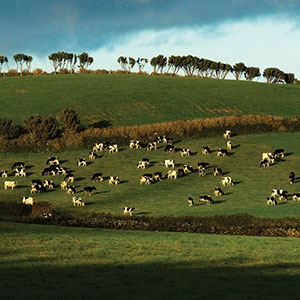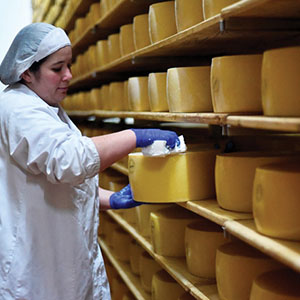Towering grassy cliffs emerge from the atlantic ocean to form what some call “The Island of Cheese.”
Nine hundred miles off the coast of Portugal, the island of São Jorge is a sparsely populated outcropping in the Azores covered with wild hydrangeas, rolling hills, churches and thousands of cows. It’s estimated that twice as many cows live on the island as people, since there are just 9,000 human inhabitants here.
The rich volcanic soil, mild and damp climate and central post in the middle of the Atlantic created a place where sailors could stop for provisions in the days when long voyages at sea were the only means of reaching a destination. This reason and more are credited with giving rise to the island’s rich cheese culture.

In fact, São Jorge’s economy is driven by cheesemaking, and island time is set by when the cows need milking. Its isolation has given way to a unique cheese still made using traditional methods. The equipment may be new and modern – stainless steel instead of wood – but the basics have remained pure to this unique culture.
It’s estimated cheese production accounts for 70 percent of the economy on São Jorge. Each year, cows produce 30 million liters of milk, every drop of it used in the production of cheese.
Updating an Ancient Process
Cheesemaker José Oliveira grew up in a small town called Norté Pequeno, on the island’s north side.
Oliveira has spent his professional career making cheese, rising through the ranks from factory operator to master cheesemaker. He has been making São Jorge cheese – or queijo São Jorge as it’s also known – for nearly 40 years. He works at one of the three cooperatives on the island that churn out 22-pound wheels of cheese.
Notable for its firm, crumbly texture similar to Cheddar, São Jorge cheese is made twice a day with fresh, raw milk. Its makeup is a nod to its past, when sailors would seek out this cheese as a durable staple that could withstand long voyages at sea.
Because of the method of packing and compressing curds into metal molds, each wedge of buttery yellow cheese is dotted with tiny, irregular eyes. As it ages, São Jorge cheese transforms from a slightly sweet, mild flavor to a certain tang and spiciness.
An aromatic grassy scent reflects the rolling green hills of the product’s origin. Each wheel is surrounded with a natural golden rind.
One dairy on the island produces cheese with a Protected Designation of Origin seal, which was awarded to São Jorge cheese aged more than 90 days.
“São Jorge cheese is special for many reasons,” says Oliveira, crediting the island’s geography, free-roaming cows and unique processing methods with imparting a unique taste. “It has a particular flavor and aroma, with a slightly spicy taste that will not be found in another cheese.”
The process begins between 5:30 and 8:30 p.m., when cows are milked in huts or in the fields where they graze.

“In São Jorge, the cows are fed mainly by grazing on the fresh grass in the pasture,” says Oliveira.
Raw, still-warm-from-the-cow milk is immediately delivered to the three cheesemaking factories on the island where, starting at 9 p.m., tanks are filled with milk. This is then heated and rennet added, causing the milk to break down into curds and whey. The curds are first cut into cubes and then further cooked and agitated by blades. With the whey drained off, cheesemakers salt the curds by hand and eventually pile handfuls into molds that are weighted down and form large wheels of cheese.
There is still one secret unique to the ancient art of cheesemaking. Instead of using commercial or even native cultures that are added to the milk, some of the whey is retained from the last batch of cheesemaking. The whey, with its unique native cultures, is returned to the milk. Some say it’s these cultures that give São Jorge cheese its tangy notes and a flavor that cannot be replicated.
The whey cultures are natural and impart slight differences in flavor from batch to batch. Native grasses and herbs result in slight seasonal differences, which means every wheel is a unique experience for the consumer. Its ancient and natural make satisfy the need for cheeses that retain their early roots and are sustainably produced.

The cheesemaking process ends at about 4 a.m. only to start after the morning’s milking, since farmers must milk twice a day for the health of the herd. With this schedule, it’s obvious there is a constant cycle of cheesemaking.
A Traveler’s History
The cheese was first introduced by Flemish settlers, who arrived in São Jorge more than 500 years ago and brought cows to the Manhattan-sized island. With grassy rolling hills and fertile volcanic soil, these bovine had an abundance of rich feed.
Though the island remains fairly remote, it was even more isolated in centuries past. With virtually no access to food from off the island, cheese became a staple for residents of São Jorge; they incorporate it into nearly every dish.
Cheese remains part of the diet on São Jorge, where it’s eaten with oranges and bananas, served on bread and incorporated into local dishes of soups and baked beans. It is even used with fresh eggs, sugar and flour to make a sweet dessert, São Jorge pudding. This is a departure from traditional Portuguese cooking on the mainland, where cheese is not typically found in recipes.

Last year, São Jorge farmers had a unique problem. Ideal weather conditions meant there was no shortage of food for their healthy and hungry cows that produced more than enough milk; too much, in fact.
The cows on São Jorge produced 3 million extra liters of milk in 2016, a 10 percent increase when compared to historical averages. Further complicating matters, the government revoked subsidies to dairy farmers, leaving them with too much milk and little income.
So the cheesemakers went to work, and churned out even more wheels of cheese. Now there is a glut of seven-month and one-year-old aged São Jorge cheese. Although some was destined for Portugal, much of it will be eaten far from the tiny island where it was made.
It will land at places like Marnie Clarke’s Cheese Cave in Claremont, CA. Thousands of miles from the Azores, a community of Portuguese expatriates has settled 20 minutes away from the store. Clarke regularly fields calls from nostalgic customers, checking to see if she has stocked one of the large wheels of São Jorge.
“It’s a taste of home or what their grandparents grew up bringing them,” says Clarke. “For us, we always have a list going of people who are waiting for it.”
About three times a year, after hearing from several customers, Clarke stocks her shop with one of the 22-pound wheels of the creamy Azorean export.
Her other customers who haven’t grown up eating São Jorge sprinkled in main dishes don’t immediately opt for the Portuguese cheese when they visit. But once they hear the story of the tiny island smaller than Manhattan and its devoted cheesemakers, they’re intrigued and want to try it. Many end up incorporating it into a cheese platter.
We’ll get people asking about specific things from the Azores, and São Jorge is always at the top of that list,” she says.
Similarly, near Peter Endicott’s store, The Cheese Shop of Salem in Salem, MA, a flourishing Portuguese population means he often keeps São Jorge and a selection of other Portuguese cheeses in stock.
“For us, we do have a fair number of Portuguese customers, or customers with Portuguese backgrounds who come in,” he says. “They’re thrilled when they see some Portuguese cheeses. We’re carrying it for them, but then when we introduce it to someone else, it’s a very popular cheese and well received.”

“It’s a cheese that I’m excited about, because it has a lot of presence,” he says. “It’s not one I’ll start with, but if someone says something about wanting intense flavor, I’ll put that one out.”
The texture of São Jorge resembles a young Parmigiano Reggiano or a Gouda aged one year, hard but not yet crumbly. Each wheel has subtle variations in terms of tanginess, but every São Jorge is characterized by a tart, spicy flavor and tingly mouth feel, says Endicott.
While popular with people of Portuguese descent, it is no longer the cheese of ethnic communities. For people looking for something new, something to excite their taste buds with a cheese that tastes similar to Cheddar but with bolder flavors, São Jorge adds another dimension to the repertoire.
The allure of São Jorge is linked to the cheese’s history as a staple for merchants on long expeditions at sea and the storied tradition of cheesemaking on the island.
When assembling a cheese board with São Jorge, Endicott recommends cutting fairly small wedges to avoid a big, overwhelming bite of the powerful flavors. São Jorge can be accompanied by similarly bold charcuterie elements.
“This is certainly the one where, if you like your big flavors, I definitely see it with a big sausage or salami, garlic and a big red wine,” says Endicott. “This would fit with a board of big flavors.”



